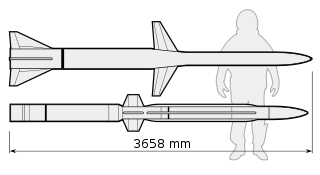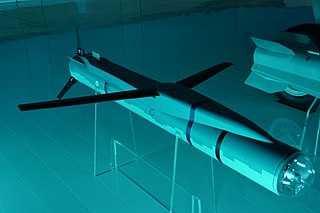Related Research Articles
The AIM-120 Advanced Medium-Range Air-to-Air Missile(AMRAAM) ( AM-ram) is an American beyond-visual-range air-to-air missile capable of all-weather day-and-night operations. It uses active transmit-receive radar guidance instead of semi-active receive-only radar guidance. When an AMRAAM missile is launched, NATO pilots use the brevity code "Fox Three".

The AIM-54 Phoenix is an American radar-guided, long-range air-to-air missile (AAM), carried in clusters of up to six missiles on the Grumman F-14 Tomcat, its only operational launch platform.

The Advanced Short Range Air-to-Air Missile (ASRAAM), also known by its United States designation AIM-132, is an imaging infrared homing air-to-air missile, produced by MBDA UK, that is designed for close-range combat. It is in service in the Royal Air Force (RAF), replacing the AIM-9 Sidewinder. ASRAAM is designed to allow the pilot to fire and then turn away before the opposing aircraft can close for a shot. It flies at well over Mach 3 to ranges in excess of 25 kilometres (16 mi). It retains a 50 g maneuverability provided by body lift technology coupled with tail control.

The Meteor is a European active radar guided beyond-visual-range air-to-air missile (BVRAAM) developed and manufactured by MBDA. It offers a multi-shot capability, and has the ability to engage highly maneuverable targets such as jet aircraft, and small targets such as UAVs and cruise missiles in a heavy electronic countermeasures (ECM) environment with a range far in excess of 200 kilometres (110 nmi).

An air-to-air missile (AAM) is a missile fired from an aircraft for the purpose of destroying another aircraft. AAMs are typically powered by one or more rocket motors, usually solid fueled but sometimes liquid fueled. Ramjet engines, as used on the Meteor, are emerging as propulsion that will enable future medium- to long-range missiles to maintain higher average speed across their engagement envelope.

The MICA, abbreviated from its full name Missile d'Interception, de Combat et d'Auto-défense or alternate translation is a French anti-air multi-target, all weather, fire-and-forget short and medium-range missile system manufactured by MBDA France. It is intended for use both by air platforms as individual missiles as well as ground units and ships, which can be equipped with the rapid fire MICA Vertical Launch System. It is fitted with a thrust vector control (TVC) system. It was developed from 1982 onward by Matra. The first trials occurred in 1991, and the missile was commissioned in 1996 to equip the Rafale and Mirage 2000. It is a replacement for both the Super 530 in the interception role and the Magic II in the dogfighting role.
Thales Air Defence Limited (TADL), formerly Shorts Missile Systems (SMS), is a defence contractor based in Belfast, Northern Ireland, producing short range air defence missiles.

The Skyflash, or Sky Flash in marketing material, was a medium-range semi-active radar homing air-to-air missile derived from the US AIM-7 Sparrow missile and carried by Royal Air Force McDonnell Douglas F-4 Phantoms and Tornado F3s, Italian Aeronautica Militare and Royal Saudi Air Force Tornados and Swedish Flygvapnet Saab Viggens.
A beyond-visual-range missile is an air-to-air missile that is capable of engaging at ranges of 20 nmi (37 km) or beyond. This range has been achieved using dual pulse rocket motors or booster rocket motor and ramjet sustainer motor.

Active radar homing (ARH) is a missile guidance method in which a missile contains a radar transceiver and the electronics necessary for it to find and track its target autonomously. The NATO brevity code for an air-to-air active radar homing missile launch is fox three.

Astra is an Indian family of all weather beyond-visual-range air-to-air missile, developed by the Defence Research and Development Organisation. Different missiles of this family are capable of engaging targets at varying distances of 500 m (0.31 mi) up to 340 km (210 mi). Astra Mk-1 has been integrated with Indian Air Force's Sukhoi Su-30MKI and will be integrated with Dassault Mirage 2000, HAL Tejas and Mikoyan MiG-29 in the future. Limited series production of Astra Mk-1 missiles began in 2017.

NASAMS is a distributed and networked short- to medium-range ground-based air defense system developed by Kongsberg Defence & Aerospace (KDA) and Raytheon. The system defends against unmanned aerial vehicles (UAVs), helicopters, cruise missiles, unmanned combat aerial vehicles (UCAVs), and fixed wing aircraft, firing any of a wide range of existing missiles.

The AIM-152 Advanced Air-to-Air Missile (AAAM) was a long-range air-to-air missile developed by the United States. The AIM-152 was intended to serve as the successor to the AIM-54 Phoenix. The program went through a protracted development stage but was never adopted by the United States Navy, due to the ending of the Cold War and the reduction in threat of its perceived primary target, Soviet supersonic bombers. Development was cancelled in 1992.
The Mitsubishi AAM-4 is a medium-range active radar homing air-to-air missile. It is a modern beyond-visual-range missile developed in Japan and intended to replace the semi-active radar homing AIM-7 Sparrow missile in service. It has been operational since 1999. The main contractor is Mitsubishi Electric. The 2010 AAM-4B was the world's first air-to-air missile with an AESA radar seeker.

The SLAMRAAM (Surface Launched AMRAAM) was the United States Army program to develop a Humvee-based surface-to-air missile launcher for the AIM-120 AMRAAM missile, manufactured by Raytheon Technologies and Kongsberg Defence & Aerospace. Surface-launched AMRAAM missile was first used in Kongsberg's NASAMS air defense system, fielded in 1995.

The Select Precision Effects At Range (SPEAR) Capability 3, or simply referred to as SPEAR 3 is a future British air-to-ground and possibly anti-ship cruise missile that could also be considered a loitering munition. It is currently planned to be integrated on the Eurofighter Typhoon, F-35B Lightning and possibly Tempest.

The PL-15 is an active radar-guided long-range air-to-air missile developed by the People's Republic of China.
The Long-Range Engagement Weapon (LREW) is a US Air Force concept for a next-generation beyond visual range air-to-air missile. Concept images shows a large, two-stage missile launched from an internal weapons bay of an F-22 Raptor. There have been some reports that the LREW is too big to fit in the F-22 or F-35 internal weapons bay and is suited for the F-15EX Eagle II or B-21 Raider. It is currently being developed by Raytheon. This program is separate from the AIM-260 JATM being developed by Lockheed Martin.
The AIM-260 Joint Advanced Tactical Missile (JATM) is an American beyond-visual-range air-to-air missile (BVRAAM) under development by Lockheed Martin. Designed to address advanced threats, the missile is expected to replace or supplement the AIM-120 AMRAAM currently in US service. The United States Department of Defense (DoD) considers the AIM-260A JATM program to be the number one air-delivered weapon priority for both the Air Force and the Navy; and its acquisition out-prioritizes other weapon system improvements and modernization efforts on any fielded aircraft.
MBDA UK is the British division of the pan-European missile systems company MBDA. Formed in 2001, the company has developed, both independently and in cooperation, a range of missile systems, including the CAMM missile family, Storm Shadow cruise missile, ASRAAM air-to-air missile and Meteor beyond-visual-range missile (BVRAAM).
References
- ↑ "Hughes pitches missile at FMRAAM project, Europe". Jane's Defence Weekly. Jane's Information Group. September 11, 1996. Archived from the original on 2013-04-11. Retrieved 2013-02-11.
- ↑ "MBDA Meteor - BVRAAM". Archived from the original on 2010-10-05. Retrieved 2013-01-09.